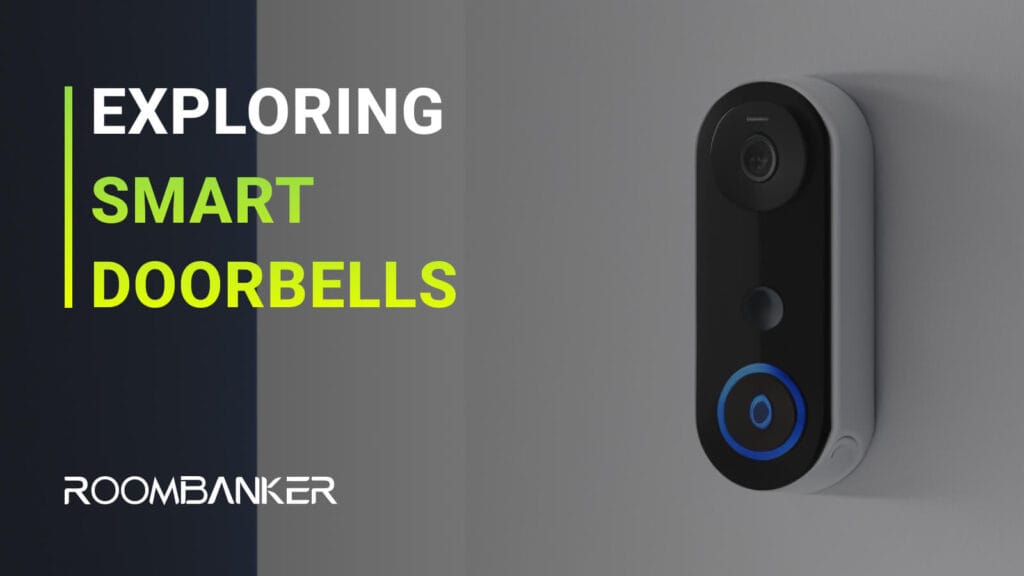
RBF Wireless Communication Chip
Long-Range, Ultra-Secure , Ultra-Low-Power Wireless Chip: Propelling IoT’s New Future
What is RBF Chip
The RBF wireless communication chip is specifically designed for complex scenarios. With five major advantages of ultra-long range, ultra-high security, ultra-low power consumption, ultra-small size, and ultra-high integration, it reshapes the connection landscape of the Internet of Things. This chip can operate stably within a wide temperature range. Innovatively, the chip, crystal oscillator, and antenna are integrated into a 10mm×10mm package. There is no need for external tuning and spectrum compliance procedures, which greatly improves the development efficiency. The chip also supports one-click switching of the world’s mainstream frequency bands, and can easily adapt to various scenarios such as global industrial IoT, smart agriculture, wireless security, and smart buildings.
Support up to 3,500m Long Range Communication in open space

(Standby mode =700nA)
Support to be powered by battery easily

Frequency-Hopping Spread Spectrum
Time Division Multiple Access
Data Encryption
Available in 433 MHz, 868 MHz, and 915 MHz frequency bands, the RBF SiP module ensures global compatibility
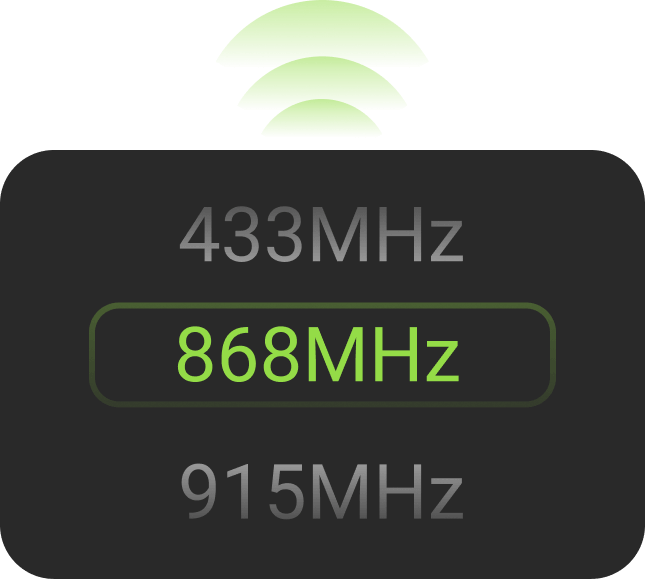
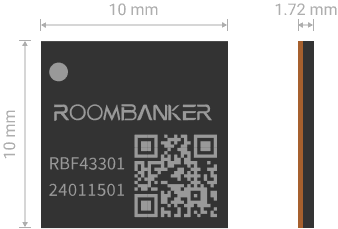
Integration of chip, crystal oscillator and antenna boosts development efficiency by 60%

Stable operation within a wide temperature range, suitable for various harsh working scenarios

Unleash the potential of chips and empower the Internet of Everything
Roombanker offers a highly integrated standard SDK, seamlessly covering every aspect from sensors to gateways. With flexible API calls, it enables developers to rapidly establish an intelligent device ecosystem. This SDK boasts remarkable dual-scenario adaptability. On the sub-device side, it focuses on low power consumption, stable networking, and intelligent management. On the gateway side, it achieves device categorization, security control, and cross-device collaboration. Thanks to standardized interfaces and modular design, developers can quickly integrate functions, significantly shortening the product time-to-market and effectively reducing development costs.
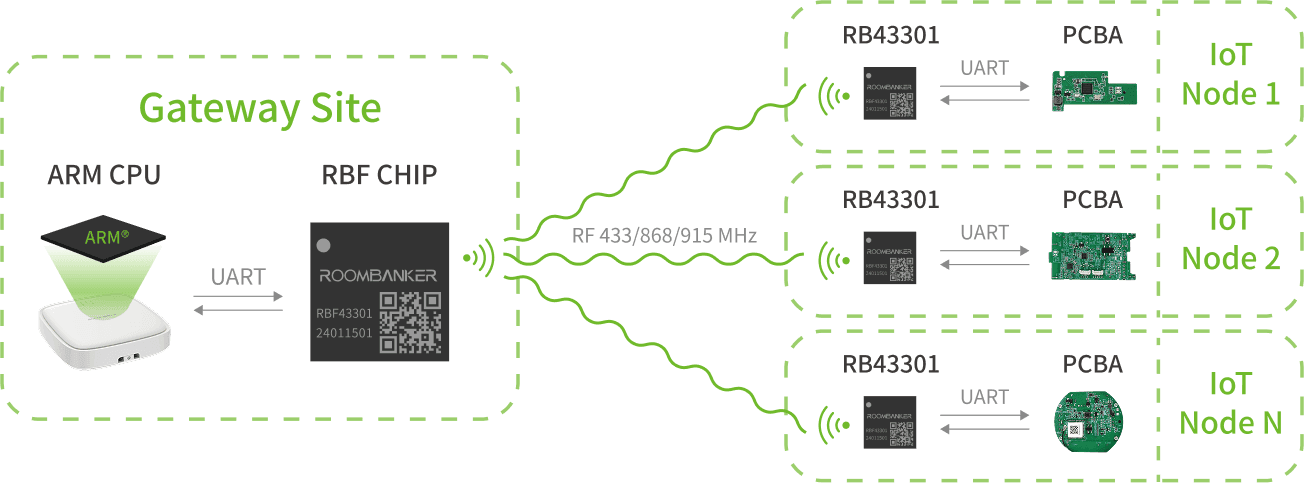
Lightweight development, focusing on core functions

Network management
Facilitate easy device onboarding, monitor device status in real-time, and ensure network stability

Power management
Switch to low-power mode, wake up as needed, and improve battery life by over 30%

Communication functions
Support heartbeat, data transmission, and broadcasting. Adapt to multiple protocols with low - latency response

OTA upgrade
Remotely upgrade firmware, conduct zero-touch maintenance, and simplify the operation and maintenance process
Provide global control and build an intelligent ecosystem

Device management
Classify and manage devices in a standardized manner, and accurately locate devices

Security control
Arm/disarm the wireless security system, issue commands synchronously, and achieve differential responses from devices

Broadcasting control
Synchronous broadcasting is suitable for low-power devices, while regular broadcasting is for long-powered devices. Automatic re-transmission ensures reliable messaging

Two - way communication
Enable direct data connection for long-powered devices. The Hub forwards data instantly, and sub-devices respond rapidly
How Roombanker Empowers Your Enterprise
“From Standalone to Intelligent: Make Your Devices Just a Tap Away”
You don’t need to form a technical team. With the RBF chip, gateway, and customized APP, you can build an intelligent system in three steps. Complete intelligent transformation in 3-6 months and seize market opportunities.

Hardware Upgrade
Embed the RBF chip (ultra-small size/ultra-low power consumption) in your device terminal to quickly achieve the device's networking capability.
Cloud Empowerment
Provide a customized gateway, supporting the access of a large number of devices and stable
APP Development
Combined with your actual usage needs, we will develop an exclusive APP for you, supporting functions such as remote control, data visualization, and OTA upgrade.
“From 100 Meters to 3,500 Meters: Make Your IoT Reach Farther and More Powerful”
There is no need to overthrow the original system. Just replace it with an RBF chip to easily achieve ultra-long-distance, ultra-high-security and stable communication, unlocking broader application scenarios and commercial values.

Hardware Upgrade
Replace the original Bluetooth/Zigbee module with an RBF chip while retaining the original system architecture.
Software Support
Provide an SDK (Software Development Kit) and API (Application Programming Interface) to quickly integrate into the existing system.
Scenario Expansion
Through the ultra-long and stable communication of 3,500 meters, it supports the interconnection of devices in a more extensive environment.
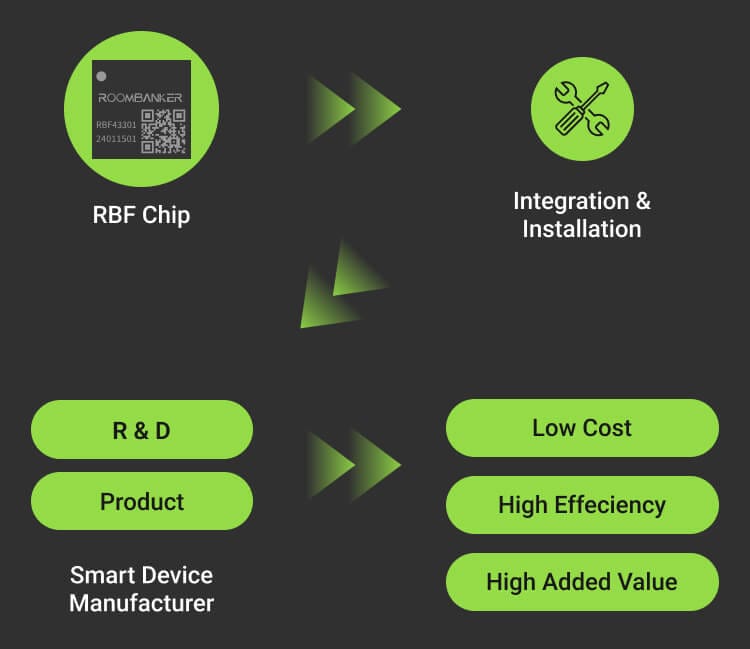

RBF Performance Comparison with Zigbee and LoRa
RBF protocol outshines ZigBee and LoRa with remarkable advantages. It features an extended communication range, high-speed data transmission, enhanced security, and lower power consumption. Chips equipped with the RBF protocol stand out in intelligent wireless IoT scenarios. They effortlessly meet diverse requirements, fueling the development of the industry.
| RBF | Zigbee | LoRa | |
|---|---|---|---|
| Modulation | DSSS/FSK | DSSS | CSS |
| Standard | IEEE802.15.4 Like MAC | IEEE802.15.4 MAC | LoRaWAN |
| Spectrum | Sub-GHz | 2.4GHz | Sub-GHz |
| Speed | 2 kbps-1 Mbps | 250 kpbs | 0.3-50 kbps |
| Distance | 3.5 km | 0.1 km | 1 km - 10 km |
| Device Access | Random Access + TDMA | Random Access | FDMA Random Access |
| Topology | Star | Mesh | Star |
| Power Consumption | Standby Power < 2uA | Standby Power Approx. 2uA | Standby Power Approx. 2uA |
| Encryption | AES-CCM + Random Number Key | AES-CCM | AES-128 |
| OTA | Support (Multicast, Background Updates) | Support | Support |
| Pros & Cons | Real-time Downlink Data Transmission in Low-power Mode: 2-second downlink broadcast window with power consumption less than 15uA; FHSS Frequency Hopping: anti-interference and maximize spectrum utilization; TDMA: improve channel utilization; OTA Multicast & Background Transmission: easier and efficient for multi-device firmware updates. | Rich ecosystem; Shorter Transmission Distance: suitable for in-home applications; Extensive Protocol Stack: require more resources and higher costs. | Large Capacity: a gateway chipset has 8 independent channels allowing for FDMA, accommodating extensive connected devices. Spread Spectrum Modulation: high sensitivity, excellent signal-to-noise ratio, good tolerance to frequency deviations or variations in crystal oscillators, and fine adaptability to environmental conditions. |
Versatile Applications: The RBF Chip in Action
Integrating RBF chips is effortless, turning your ideas into reality. Across wireless security, smart buildings, industrial IoT, and smart agriculture, RBF chips unlock industry potential and drive growth.








